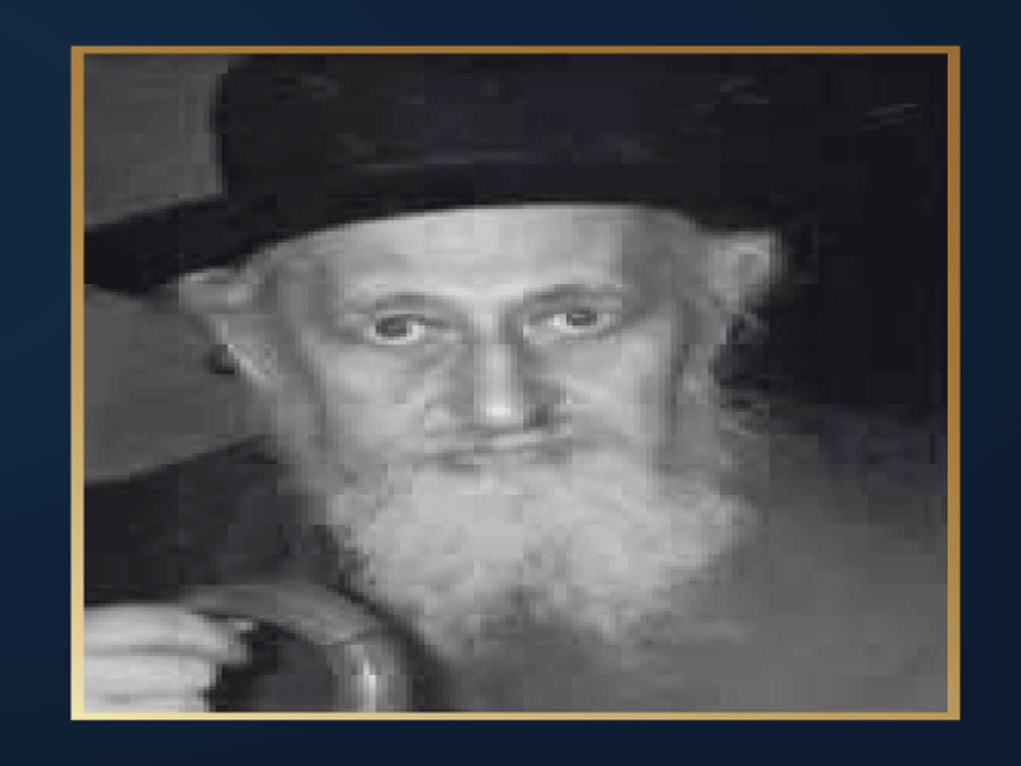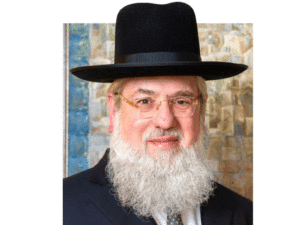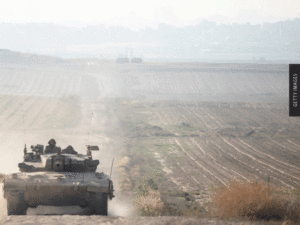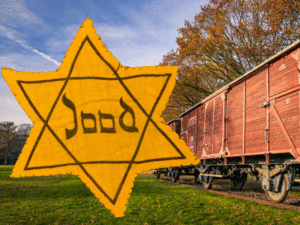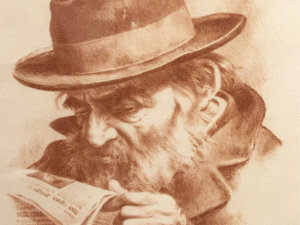Rav Yitzchok Zev Soloveitchik zt”l, the Brisker Rov (5647/1886–5720/1959), was a gadol b’Yisroel who was renowned for his clarity in all spheres of Torah as well as for his tenacity in observing the minutest details of mitzvos. The Brisker derech of Torah study, involving analytical categorization, which he garnered from his illustrious father, Rav Chaim Soloveitchik, has paved the way for talmidei hayeshivos to attain keen understanding of difficult Talmudic concepts.
The Brisker Rov was born in Volozhin to Rav Chaim and Rebbitzen Lifsha, daughter of Rav Refoel Shapiro and granddaughter of the Netziv. He studied under his father, and was chiefly responsible for popularizing the Brisker derech of learning amongst the olam haTorah. He was appointed as rov in Brisk upon his father’s passing in 1918. He also headed the yeshiva in Brisk where he gave shiur to select talmidim. He and some of his children narrowly escaped the ravages of the Holocaust, immigrating to Eretz Yisroel in 1940, but his wife Hendyl and their younger children were murdered by the Nazis, ym”sh.
The Brisker Rov reestablished the Brisk Yeshiva in Yerushalayim. At the same time, he was at the forefront of all the major issues that Klal Yisroel faced. His daas Torah was the final word throughout the community. His descendants and pupils continue to teach thousands of talmidim in various yeshivos following the Brisker derech halimud.
The following are several of his chiddushei Torah, so you may glimpse a bit of the Brisker Rov’s brilliance.
- • • • •
In Mussaf of Rosh Hashanah, we say in Zichronos, “Zeh hayom techilas ma’asecha zikaron l’yom rishon – This day is the anniversary of the start of Your handiwork, a remembrance of the first day,” referring to mankind’s creation, which was on Rosh Hashanah. What is the relevance of man’s creation to our day of judgment that the Anshei Knesses Hagedolah inserted this phrase into the Rosh Hashanah davening?
The Brisker Rov shares with us the Medrash (Bereishis Rabbah 8:5) that elaborates on the posuk (Tehillim 85:11): “Chesed v’emes nifgashu tzedek v’shalom nashaku – Kindness and truth have met, righteousness and peace have kissed.” Chesed declares that man should be created, as he will do chesed. Emes contends not to create man, as he will lie. Tzedek says to create man, as he will perform tzedakah. Shalom says do not create man, as he will cause strife.
Rashi (Bereishis 1:26) on the posuk of “Vayomer Elokim naaseh adam” explains that Hashem and His bais din ultimately decided to create man. We see that man was created within the process of din, judgment. Therefore, on Rosh Hashanah, when we are subject to din, we cite the din that occurred during creation of mankind, when Hashem ruled in favor of mankind and created man. We pray that we will be meritorious on this yom hadin, as man was on the day of his creation (Chiddushei Hagri”z, stencils, 137).
- • • • •
The Torah (Vayikra 23:40) commands, “Ulikachtem lochem bayom harishon pri etz hadar … usemachtem lifnei Hashem – And you should take for yourselves on the first day the esrog … and you shall rejoice before Hashem.” Why is the mitzvah of simcha, rejoicing, specifically juxtaposed with the mitzvah of lulav?
The Brisker Rov cites the Ramban in Sefer Hamitzvos who states, based on the Gemara in Pesachim (117a), “Efsher Yisroel shachatu es pischeihen venotlu luloveihen velo amru shirah?” that the obligation of saying Hallel while taking the lulav is the same Torah obligation as saying Hallel when sacrificing the Korban Pesach. The Ramban says further that saying this shirah is part of the mitzvah of simcha one must have on Yom Tov.
This explains the juxtaposition of simcha with the mitzvah of taking the lulav. The Torah is requesting of us to rejoice during the lulav-taking, which we fulfill through saying Hallel while taking the lulav (Chiddushei Ri”z Halevi, Emor).
- • • • •
In Parshas Ki Sisa (Shemos 31:13), Hashem instructs Klal Yisroel to observe Shabbos: “Ach es Shabbsosai tishmoru ki ois hee… Ushemartem es haShabbos – However, you must observe My Shabbosos, for it is a sign … you shall observe My Shabbos.” Why does Hashem initially refer to Shabbos in plural form, Shabbsosai, and later on as Shabbos, in singular form?
The Brisker Rov explains there are two purposes of observing Shabbos. One is to commemorate our leaving Mitzrayim, which is the foundation of our uniqueness and kedusha as stated in the Aseres Hadibros (Shemos 20:2): “I am Hashem, your G-d, who took you out of Mitzrayim.” Moreover, the exodus from Mitzrayim created a special bond between Hashem and Klal Yisroel, as it says, “Ois hee l’olam – This is a sign for eternity.”
The other purpose of observing Shabbos is to commemorate Hashem’s creating the world during six days and resting on Shabbos.
Recalling our leaving Mitzrayim is not unique to Shabbos. Our Yomim Tovim are zeicher l’Yetzias Mitzrayim as well. They are all reckoned as an ois and that is why we are exempt from putting on tefillin on all the mo’adim. Rashi (Eiruvin 96a and Menachos 36b) expounds that the aforementioned ois applies to all the Yomim Tovim as well as Shabbos. Therefore, the Torah, when first affixing ois to Shabbos, refers to Shabbos as Shabbsosai, in plural, as this Shabbos refers to the Yomim Tovim as well (Rashi, Shavuos 15b).
However, the second ois is referring to the ois given to us relevant to maaseh bereishis, creation, and that one refers solely to Shabbos. Therefore, the Torah refers to it as haShabbos, the Shabbos, in singular form (Chiddushei Ri”z Halevi, Ki Sisah).
- • • • •
When Hashem initially instructs Klal Yisroel to bring the Korban Tomid twice daily, the Torah in Parshas Tetzaveh (Shemos 29:39) commands to bring “es hakeves ha’echad,” while in Parshas Pinchos (Bamidbar 28:4) the Torah requests us to bring hakeves echad, without the appellation of the letter hey to echad. Why the change?
The Brisker Rov says that the Gemara in Menachos (49a) teaches that the two temidim brought daily are independent of one another. If for some reason the korban tomid of the morning was not brought, the korban tomid of the afternoon may be brought onto the mizbei’ach. However, the first time that korbanos were brought had a special dispensation unique to them. Since these korbanos were inaugurating the mizbei’ach, they had to be brought according to plan. This means that if for whatever reason the korban tomid of the morning was not brought, the tomid of the afternoon would also not be brought.
Therefore, in Parshas Tzetzaveh, which discusses the inauguration of the mizbei’ach, the Torah emphasizes hakeves ha’echad, ha’echad meaning “the first one.” This korban was required to be the first korban no matter what. However, Parshas Pinchos discusses the halachos of korbanos in general, not specifically the inaugural korban. Pertaining to the daily requirements, there is no necessity to bring the morning tomid vis-à-vis the afternoon tomid. Thus, the Torah writes simply hakeves echad, echad meaning one (Chiddushei Ri”z Halevi, Tetzaveh).
- • • • •
Targum Onkelos (Bereishis 24:67) says that when Yitzchok married Rivkah, Yitzchok took her to Sarah’s tent and saw how her ways were proper, and he proceeded to marry her. The earlier posuk tells us how Eliezer related to Yitzchok about all the miracles that transpired as Eliezer tried to ascertain that Rivkah was the right wife for Yitzchok.
As Eliezer travelled, the land sprung forth before him. When Besu’el tried to neutralize Eliezer, a malach killed him. There were nissim gluyim, open miracles, throughout this time period. Nevertheless, Yitzchok only took her as a wife after he ascertained her refinement and good character (Chiddushei Hagri”z, stencils, 20).
- • • • •
Chazal tell us (Yoma 28b) that the avos kept the Torah and its mitzvos even prior to receiving it. If so, how come Avrohom did not circumcise himself until Hashem commanded him to do so?
The Brisker Rov offers that in order to be obligated in bris milah, one has to be reckoned as an areil, uncircumcised. Then, the act of bris milah removes the areil status from the person. However, until Avrohom was commanded to undergo bris milah, the concept of areil did not exist. Therefore, it was impossible to perform bris milah, as there was no concept of areil on the world.
The Brisker Rov uses this same logic to answer how Yaakov was permitted to marry two sisters, Rochel and Leah. If the avos kept the Torah, how was Yaakov permitted to marry them both?
The Brisker Rov answers that the issue of marrying two sisters can only exist if the marriage consummated is a marriage of kedushas Yisroel. The marriage of a ben Noach is not reckoned as a marriage to invoke issurim therefrom. Therefore, Yaakov marrying Leah did not preclude him from marrying Rochel (Chiddushei Hagri”z, stencils, 5).
- • • • •
R’ Mendy Pollak learns and teaches Torah on Manhattan’s Upper West Side.
